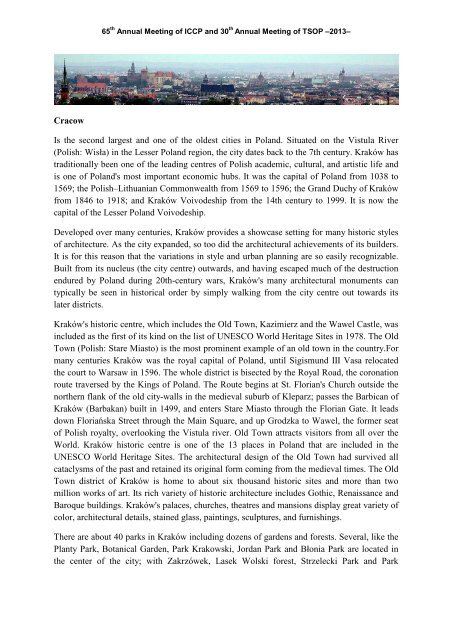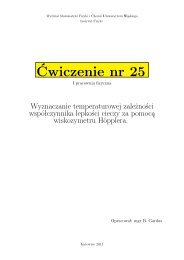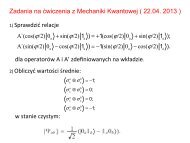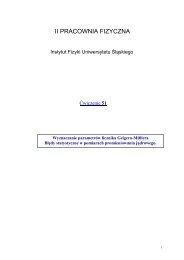Cracow Is the second largest and one of the oldest cities in Poland ...
Cracow Is the second largest and one of the oldest cities in Poland ...
Cracow Is the second largest and one of the oldest cities in Poland ...
You also want an ePaper? Increase the reach of your titles
YUMPU automatically turns print PDFs into web optimized ePapers that Google loves.
65 th Annual Meet<strong>in</strong>g <strong>of</strong> ICCP <strong>and</strong> 30 th Annual Meet<strong>in</strong>g <strong>of</strong> TSOP –2013–<strong>Cracow</strong><strong>Is</strong> <strong>the</strong> <strong>second</strong> <strong>largest</strong> <strong>and</strong> <strong>one</strong> <strong>of</strong> <strong>the</strong> <strong>oldest</strong> <strong>cities</strong> <strong>in</strong> Pol<strong>and</strong>. Situated on <strong>the</strong> Vistula River(Polish: Wisła) <strong>in</strong> <strong>the</strong> Lesser Pol<strong>and</strong> region, <strong>the</strong> city dates back to <strong>the</strong> 7th century. Kraków hastraditionally been <strong>one</strong> <strong>of</strong> <strong>the</strong> lead<strong>in</strong>g centres <strong>of</strong> Polish academic, cultural, <strong>and</strong> artistic life <strong>and</strong>is <strong>one</strong> <strong>of</strong> Pol<strong>and</strong>'s most important economic hubs. It was <strong>the</strong> capital <strong>of</strong> Pol<strong>and</strong> from 1038 to1569; <strong>the</strong> Polish–Lithuanian Commonwealth from 1569 to 1596; <strong>the</strong> Gr<strong>and</strong> Duchy <strong>of</strong> Krakówfrom 1846 to 1918; <strong>and</strong> Kraków Voivodeship from <strong>the</strong> 14th century to 1999. It is now <strong>the</strong>capital <strong>of</strong> <strong>the</strong> Lesser Pol<strong>and</strong> Voivodeship.Developed over many centuries, Kraków provides a showcase sett<strong>in</strong>g for many historic styles<strong>of</strong> architecture. As <strong>the</strong> city exp<strong>and</strong>ed, so too did <strong>the</strong> architectural achievements <strong>of</strong> its builders.It is for this reason that <strong>the</strong> variations <strong>in</strong> style <strong>and</strong> urban plann<strong>in</strong>g are so easily recognizable.Built from its nucleus (<strong>the</strong> city centre) outwards, <strong>and</strong> hav<strong>in</strong>g escaped much <strong>of</strong> <strong>the</strong> destructi<strong>one</strong>ndured by Pol<strong>and</strong> dur<strong>in</strong>g 20th-century wars, Kraków's many architectural monuments cantypically be seen <strong>in</strong> historical order by simply walk<strong>in</strong>g from <strong>the</strong> city centre out towards itslater districts.Kraków's historic centre, which <strong>in</strong>cludes <strong>the</strong> Old Town, Kazimierz <strong>and</strong> <strong>the</strong> Wawel Castle, was<strong>in</strong>cluded as <strong>the</strong> first <strong>of</strong> its k<strong>in</strong>d on <strong>the</strong> list <strong>of</strong> UNESCO World Heritage Sites <strong>in</strong> 1978. The OldTown (Polish: Stare Miasto) is <strong>the</strong> most prom<strong>in</strong>ent example <strong>of</strong> an old town <strong>in</strong> <strong>the</strong> country.Formany centuries Kraków was <strong>the</strong> royal capital <strong>of</strong> Pol<strong>and</strong>, until Sigismund III Vasa relocated<strong>the</strong> court to Warsaw <strong>in</strong> 1596. The whole district is bisected by <strong>the</strong> Royal Road, <strong>the</strong> coronationroute traversed by <strong>the</strong> K<strong>in</strong>gs <strong>of</strong> Pol<strong>and</strong>. The Route beg<strong>in</strong>s at St. Florian's Church outside <strong>the</strong>nor<strong>the</strong>rn flank <strong>of</strong> <strong>the</strong> old city-walls <strong>in</strong> <strong>the</strong> medieval suburb <strong>of</strong> Kleparz; passes <strong>the</strong> Barbican <strong>of</strong>Kraków (Barbakan) built <strong>in</strong> 1499, <strong>and</strong> enters Stare Miasto through <strong>the</strong> Florian Gate. It leadsdown Floriańska Street through <strong>the</strong> Ma<strong>in</strong> Square, <strong>and</strong> up Grodzka to Wawel, <strong>the</strong> former seat<strong>of</strong> Polish royalty, overlook<strong>in</strong>g <strong>the</strong> Vistula river. Old Town attracts visitors from all over <strong>the</strong>World. Kraków historic centre is <strong>one</strong> <strong>of</strong> <strong>the</strong> 13 places <strong>in</strong> Pol<strong>and</strong> that are <strong>in</strong>cluded <strong>in</strong> <strong>the</strong>UNESCO World Heritage Sites. The architectural design <strong>of</strong> <strong>the</strong> Old Town had survived allcataclysms <strong>of</strong> <strong>the</strong> past <strong>and</strong> reta<strong>in</strong>ed its orig<strong>in</strong>al form com<strong>in</strong>g from <strong>the</strong> medieval times. The OldTown district <strong>of</strong> Kraków is home to about six thous<strong>and</strong> historic sites <strong>and</strong> more than twomillion works <strong>of</strong> art. Its rich variety <strong>of</strong> historic architecture <strong>in</strong>cludes Gothic, Renaissance <strong>and</strong>Baroque build<strong>in</strong>gs. Kraków's palaces, churches, <strong>the</strong>atres <strong>and</strong> mansions display great variety <strong>of</strong>color, architectural details, sta<strong>in</strong>ed glass, pa<strong>in</strong>t<strong>in</strong>gs, sculptures, <strong>and</strong> furnish<strong>in</strong>gs.There are about 40 parks <strong>in</strong> Kraków <strong>in</strong>clud<strong>in</strong>g dozens <strong>of</strong> gardens <strong>and</strong> forests. Several, like <strong>the</strong>Planty Park, Botanical Garden, Park Krakowski, Jordan Park <strong>and</strong> Błonia Park are located <strong>in</strong><strong>the</strong> center <strong>of</strong> <strong>the</strong> city; with Zakrzówek, Lasek Wolski forest, Strzelecki Park <strong>and</strong> Park
65 th Annual Meet<strong>in</strong>g <strong>of</strong> ICCP <strong>and</strong> 30 th Annual Meet<strong>in</strong>g <strong>of</strong> TSOP –2013–Lotników (among o<strong>the</strong>rs) <strong>in</strong> <strong>the</strong> surround<strong>in</strong>g districts. Parks cover about 318.5 hectares(2002) <strong>of</strong> <strong>the</strong> city.The Planty Park is <strong>the</strong> best-known park <strong>in</strong> Kraków. It was established between 1822 <strong>and</strong> 1830<strong>in</strong> place <strong>of</strong> <strong>the</strong> old city walls, form<strong>in</strong>g a green belt around <strong>the</strong> Old Town. It consists <strong>of</strong> a cha<strong>in</strong><strong>of</strong> smaller gardens designed <strong>in</strong> various styles <strong>and</strong> adorned with monuments. The park has anarea <strong>of</strong> 21 hectares (52 acres) <strong>and</strong> a length <strong>of</strong> 4 kilometers (2.5 mi), form<strong>in</strong>g a scenic walkwaypopular with Cracovians.The Jordan Park founded <strong>in</strong> 1889 by Dr Henryk Jordan, was <strong>the</strong> first public park <strong>of</strong> its k<strong>in</strong>d <strong>in</strong>Europe. The park built on <strong>the</strong> banks <strong>of</strong> <strong>the</strong> Rudawa river was equipped with runn<strong>in</strong>g <strong>and</strong>exercise tracks, playgrounds, <strong>the</strong> swimm<strong>in</strong>g pool, amphi<strong>the</strong>atre, pavilions, <strong>and</strong> a pond for boatrow<strong>in</strong>g <strong>and</strong> water bicycles. It is located on <strong>the</strong> grounds <strong>of</strong> a larger Kraków’s Błonia Park.The less prom<strong>in</strong>ent Park Krakowski was founded <strong>in</strong> 1885 by Stanisław Rehman but has s<strong>in</strong>cebeen greatly reduced <strong>in</strong> size because <strong>of</strong> rapid real estate development. It was a populardest<strong>in</strong>ation po<strong>in</strong>t with many Cracovians at <strong>the</strong> end <strong>of</strong> <strong>the</strong> 19th century.(http://en.wikipedia.org/wiki/Krak%C3%B3w)The Wawel Castle (http://en.wikipedia.org/wiki/Krak%C3%B3w)
65 th Annual Meet<strong>in</strong>g <strong>of</strong> ICCP <strong>and</strong> 30 th Annual Meet<strong>in</strong>g <strong>of</strong> TSOP –2013–Renaissance Cloth Hall (Sukiennice) <strong>in</strong> Ma<strong>in</strong> Market Square(http://en.wikipedia.org/wiki/File:Krak%C3%B3w_-_Sukiennice_01_cropped.jpg)Kanonicza Street, which leads to <strong>the</strong> Wawel, is home to a number <strong>of</strong> 16th <strong>and</strong> 17th centuryarchitectural masterpieces(http://en.wikipedia.org/wiki/File:Krak%C3%B3w_Kanonicza_Wawel.JPG)
65 th Annual Meet<strong>in</strong>g <strong>of</strong> ICCP <strong>and</strong> 30 th Annual Meet<strong>in</strong>g <strong>of</strong> TSOP –2013–Palace <strong>of</strong> Art at Szczepański Square (view from Planty), prime example <strong>of</strong> Art Nouveauarchitecture <strong>in</strong> central Kraków(http://en.wikipedia.org/wiki/File:Sztuka_Krakow.jpg)
65 th Annual Meet<strong>in</strong>g <strong>of</strong> ICCP <strong>and</strong> 30 th Annual Meet<strong>in</strong>g <strong>of</strong> TSOP –2013–Founta<strong>in</strong>, Planty Park(http://en.wikipedia.org/wiki/File:006Planty.JPG)
65 th Annual Meet<strong>in</strong>g <strong>of</strong> ICCP <strong>and</strong> 30 th Annual Meet<strong>in</strong>g <strong>of</strong> TSOP –2013–St. Mary's Basilica (Polish: Kościół Mariacki)(http://en.wikipedia.org/wiki/File:Krak%C3%B3w_-_St._Mary_Church_01.JPG)
















